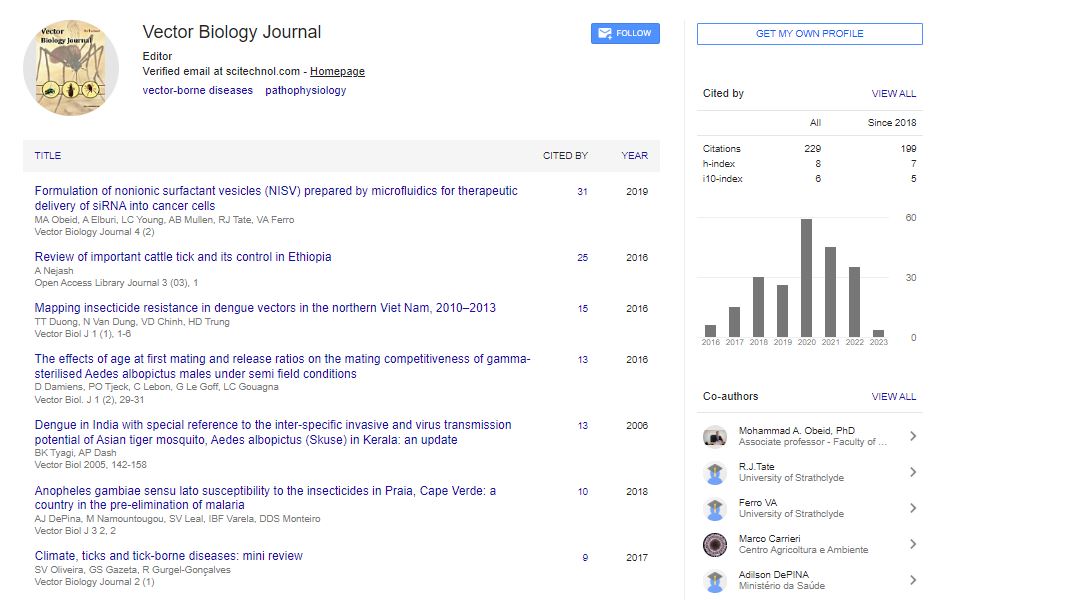Opinion Article, Vector Biol J Vol: 8 Issue: 4
Factors Influencing Vector-Parasite Interactions and its Implications
Megan Petros*
1Department of Infectious Diseases, University of Oxford, Oxford, United Kingdom
*Corresponding Author: Megan Petros,
Department of Infectious Diseases,
University of Oxford, Oxford, United Kingdom
E-mail: petr.meg@gmail.com
Received date: 21 November, 2023, Manuscript No. VBJ-24-127992;
Editor assigned date: 23 November, 2023, PreQC No. VBJ-24-127992 (PQ);
Reviewed date: 07 December, 2023, QC No. VBJ-24-127992;
Revised date: 15 December, 2023, Manuscript No. VBJ-24-127992 (R);
Published date: 22 December, 2023, DOI: 10.4172/2473-4810.1000280.
Citation: Petros M (2023) Factors Influencing Vector-Parasite Interactions and its Implications. Vector Biol J 8:4.
Description
Vector-parasite interactions play a significant role in the transmission of various infectious diseases, shaping the epidemiology and impact of vector-borne pathogens on human and animal populations. These interactions involve complex molecular, physiological, and ecological processes that determine the success of pathogen transmission from the vector to the host.
Vector-parasite interactions occur when pathogens, such as viruses, bacteria, protozoa, or helminths, interact with arthropod vectors, including mosquitoes, ticks, flies, and fleas, during their life cycle. These interactions can occur at various stages of the pathogen's development within the vector, including ingestion, colonization, replication, dissemination, and transmission to the host.
Mechanisms of vector-parasite interactions
Pathogens must adhere and enter certain tissues inside the vector to cause infection. Adhesion molecules on the surface of the pathogen interact with receptors on the vector's epithelial cells, facilitating attachment and entry. Once inside the vector, pathogens may encounter physical and immune barriers that must be overcome for successful invasion and colonization.
Vector immune response plays an important role in limiting pathogen replication and transmission. However, pathogens have evolved various methods to evade or suppress vector immune defenses, allowing them to establish persistent infections and facilitate transmission to the host. These techniques may include modulation of vector immune signaling pathways, production of immune evasion proteins, or manipulation of vector cellular processes.
Factors influencing vector-parasite interactions
Several factors influence the dynamics of vector-parasite interactions, including:
Vector competence: Vector competence refers to the ability of vector organisms to become infected with, maintain, and transmit a particular pathogen. Variability in vector competence among different vector organisms or populations can impact the efficiency and intensity of pathogen transmission within a given ecosystem.
Pathogen genetics: Genetic variability within pathogen populations can influence interactions with vector tissues, replication kinetics, and transmission efficiency. Certain pathogen strains may exhibit enhanced adaptation to specific vector organisms or environments, resulting in differences in vector-parasite interactions and transmission dynamics.
Vector physiology and genetics: Vector physiological factors, such as midgut barrier function, immune responses, and vector lifespan, can influence the outcome of vector-parasite interactions. Genetic variability within vector populations may also impact susceptibility to infection, vector competence, and vector-pathogen compatibility.
Environmental factors: Environmental conditions, including temperature, humidity, and habitat suitability, can affect vectorparasite interactions by influencing vector behavior, vector population dynamics, and pathogen transmission dynamics. Climate change and anthropogenic alterations to natural habitats can further impact vectorparasite interactions and disease transmission patterns.
Implications for disease control and prevention
Understanding the mechanisms and dynamics of vector-parasite interactions has important implications for disease control and prevention:
Targeted vector control: Knowledge of vector-parasite interactions can inform targeted vector control interventions aimed at reducing vector populations, interrupting transmission cycles, and mitigating disease burden. Techniques such as insecticide-treated bed nets, indoor residual spraying, and larval source reduction can effectively reduce vector populations and prevent disease transmission.
Vaccine and drug development: Insights into vector-parasite interactions can facilitate the development of vaccines and therapeutics targeting specific levels of the pathogen life cycle within the vector. By understanding the molecular mechanisms underlying vector-pathogen interactions, researchers can identify potential targets for intervention and control.
Disease surveillance and monitoring: Monitoring vector-parasite interactions can help with an illness. Surveillance efforts by identifying important vector organisms responsible for pathogen transmission and detecting emerging threats. Surveillance data can guide public health interventions and resource allocation to prevent and control outbreaks.
 Spanish
Spanish  Chinese
Chinese  Russian
Russian  German
German  French
French  Japanese
Japanese  Portuguese
Portuguese  Hindi
Hindi 